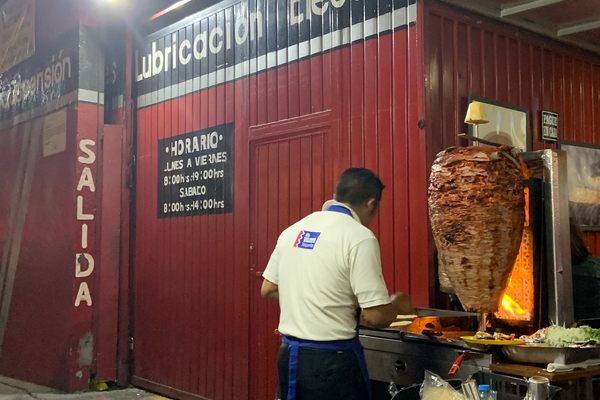
Amber Mines in Mexico Offer Hope, Hazards, and ‘A Perfect Time Capsule’
In Simojovel’s network of dark tunnels, workers risk their lives to find coveted treasures that preserve a distant past.
Patricia Diaz Ruiz walks past the jewelry stands crowding the central plaza of Simojovel, a mountain town in Mexico’s southernmost state of Chiapas. She picks up pieces of amber, inspecting them with a loupe and a black light. “I like to see what makes it to the main market, just in case,” she says. “But I head to the mines every week. That’s where you find the best surprises.” Ruiz is the daughter of a fourth-generation amber miner. She sells the rarest pieces of the fossilized tree resin, such as red amber with bees, spiders, or flies trapped inside. The mines are less than a mile from the plaza, past rolling hills covered in corn, banana, and coffee plantations.

“I’ll agree to take you there on the condition that you understand the dangers involved,” Ruiz says of the mines. The walk cuts through flowering coffee fields that fill the air with a thick, sweet fragrance as the sound of traffic is replaced with the buzz of cicadas. Ruiz runs down a list of hazards: The mine’s tunnels are mazelike, prone to collapse, and filled with noxious gases. Some of the threats are human in nature. Ruiz says the trade is controlled by criminal organizations; a couple of years back, she cautions, a French amber dealer lost his ear to bandits.
The current trade is just the latest chapter in Simojovel’s long relationship with the fossilized resin, which is more than 22 million years old. Nearly 4,000 years ago, the ancient Maya pierced their noses and ears with it; later, it was paid as tribute by the Zinacatepec people of the area to the Aztec kings, up until the 15th century. Amber was not just prized as a jewel; it was also believed to possess magic healing and protective properties. In Simojovel, curanderos, local shamans, still claim to cure arthritis with amber and egg white potions, and use incense made from the material in their ceremonies.
Near the mine entrance, the lush fields give way to mounds of discarded rock. Children pick over the pieces and hammer away at the bigger chunks, in search of overlooked amber. A man emerges from the mind with a cart piled with more rock, which he tips onto one of the heaps. For a small fee, Gildardo, who refuses to give his last name, agrees to take us in. Guided only by a headlamp, he pushes his cart through more than a half-mile of winding tunnels, heading deeper into the darkness. The air is thick with humidity and smells of sulfur.

Gildardo retrieves his tools, a sledgehammer and a spike, which he’d hidden in a crevice. After a few minutes of hammering at the cave wall, he shines his light on a handful of small pieces of amber. At 38, he has been working in the mines for more than 20 years. He has lost friends to this place, and nearly died himself. “I was almost swallowed by the mine during the last rainy season,” he says. “I was sleeping inside when I dreamed that my home was collapsing. I woke up and rushed out right before the roof caved in.” The risk, he says, is worth it: The miners pay monthly rent to local families who own the land, and set their own schedules. A single great find can be worth up to $1,500, more than half a year’s salary for workers on the surrounding coffee plantations.
Back above ground, Ruiz buys a sack of amber at a price per gram set by the miners. She’ll drop it off at a workshop in town where Ulise Rodriguez, a 23-year-old artisan, will cut the rocks, remove the outer layers, and polish them until they shimmer, honey-colored and translucent. “When the Chinese arrived in 2014, a fever took over the town,” Rodriguez says. “They were setting their own prices and everyone wanted to find a big piece.” Rodriguez and his younger brother, just 14 at the time, got wrapped up in the fervor. “The day my brother was hit by a loose rock that fell from the ceiling, I decided to quit and dedicate my time to crafting the amber instead,” he says. His brother was in a coma for two days and, says Rodriguez, with no hospitals nearby, had to be revived by a curandero. The Chinese amber dealers were eventually run out of town by gangs, Rodriguez says. The mining remains dangerous, but prices have stabilized, and miners are now more cautious about dealing with outsiders.
The amber from Simojovel, transformed into pendants, earrings, and other jewelry, will make its way onto the international market, though researchers are occasionally able to acquire pieces to study. Gerardo Carbot-Chanona, curator of a paleontology museum in nearby Tuxtla Gutierrez, says some of the prehistoric flora and fauna preserved in the amber “challenge our understanding of Mexico’s geological past.” New species of tiny crustaceans called isopods have been identified in the amber, for example, while preserved flowers in the fossilized resin have helped researchers reconstruct an ecosystem more than 20 million years old. Carbot-Chanona recently determined that part of a shell of a 23-million-year-old pig-nosed turtle, found in one of the mines, belonged to a new species. He named it Allaeochelys liliae, after the amber seller and museum owner, Lilia Mijangos, who discovered it. “The resin is a perfect time capsule,” says Carbot-Chanona. “For a paleontologist, it is this perfect window into the past, offering a view of a world long gone in exquisite detail.”















Follow us on Twitter to get the latest on the world's hidden wonders.
Like us on Facebook to get the latest on the world's hidden wonders.
Follow us on Twitter Like us on Facebook